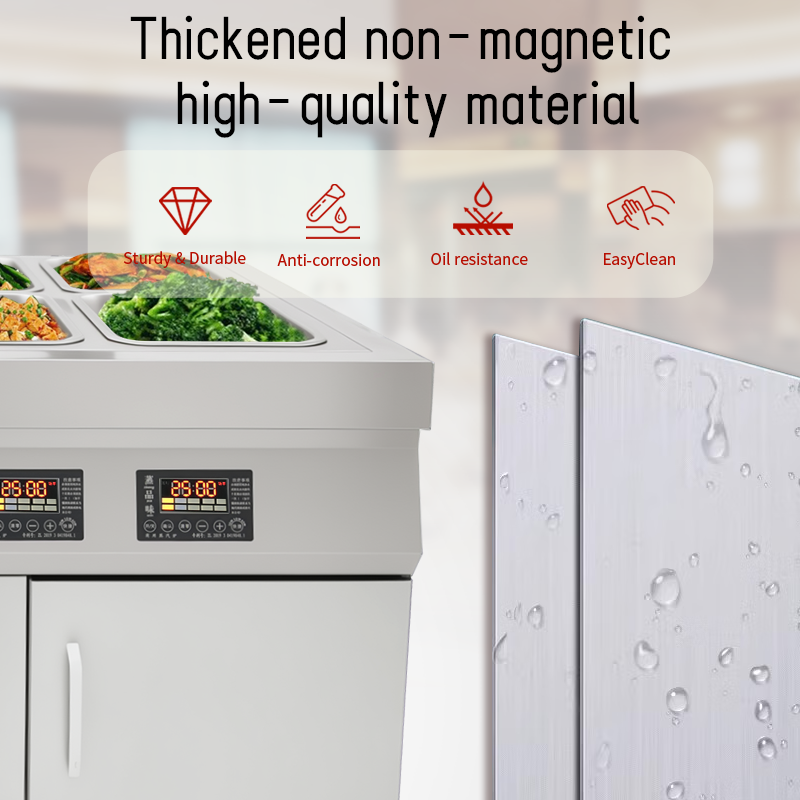In today's fiercely competitive restaurant industry, commercial kitchens have become a crucial battleground for business success. This article will delve into practical applications of commercial kitchens to improve efficiency and optimize costs, and uncover disruptive trends expected over the next five years, helping you seize industry opportunities.
I. Four Core Application Scenarios for Commercial Kitchens
1. Standardized Chain Restaurant Hubs
• Central Kitchen System: Through automated sorting and vacuum pre-cooling technology,
food waste is reduced by 25% (case study: a fast food brand achieved annual savings of $1.8 million across 200 stores).
• Intelligent Scheduling System for Commercial Kitchens: Automatically adjusts semi-finished product delivery volumes based on store sales data, increasing inventory turnover by 40%.
2. Efficient Catering Solutions for Hotels and Banquets
• Combined Cooking Equipment in Commercial Kitchens: A versatile steaming oven handles both steaming and baking, reducing meal delivery time for a 500-person banquet to 90 minutes.
• Hot Chain Preservation Technology in Commercial Kitchens: Using layered insulated food carts ensures a consistent core temperature of ≥65°C (in compliance with HACCP standards).
3. Safe Kitchens for Medical and Educational Institutions
Zone-Based Purification System: Establish allergen isolation zones (e.g., dedicated gluten/dairy workstations).
Precise Nutritional Parameters: The AI-powered meal planning system automatically calculates nutritional parameters based on patient data, with an error rate of <3%.
4. A New Model for Retail and Catering Integration
Open Kitchen Design: Transparent kitchens enhance customer trust and increase average order value by 15%
Prepared Meal Production Line: One automated packaging line processes 3,000 instant hot meal boxes daily
II. Practical Strategies for Improving Efficiency and Costs
1. Doubling Space Utilization
Pain Points, Solutions, and Efficiency Improvements
Insufficient workspace: Wall-mounted folding worktops increase effective space by 60%
Large equipment footprint: Modular smart cooking centers reduce equipment by 30%
Cluttered traffic flow: U-shaped triangle workspace design reduces employee steps by 40%
2. Key Technologies for Energy Cost Control
Real-time Monitoring System: IoT sensors dynamically adjust energy usage (Case Study: A Shanghai cafeteria saves $22,000 annually in electricity bills)
Waste Heat Recovery Device: Converts waste heat from stoves into heating, reducing gas costs by 18%
Water-saving Equipment: High-pressure spray dishwashers use 50% less water than traditional equipment
3. Paths to Optimizing Labor Costs
Automated Equipment Replacement: A single cooking robot can replace three chefs (ROI <8 months)
Smart Scheduling System: Automatically schedules based on customer flow forecasts, reducing labor waste by 25%
III. Future Trend Outlook 2025-2030
Digital Twin Kitchen (Already Implemented)
3D modeling to preview workflows and optimize layouts increases production capacity by 15% (Reference: Haidilao Smart Kitchen)
Hydrogen Energy Revolution
UK pilot program for hydrogen stoves achieves zero carbon emissions, reducing energy costs by 40%
AI Nutrition Customization System
Japanese Nursing Home Use Case: Automatically generating menus based on elderly health data
Blockchain Traceability System
Full traceability of ingredients from farm to table reduces food safety complaints by 90%
Industry Warning: FDA data shows that 68% of kitchen fires are caused by exhaust system failures. Flame suppression devices will be mandatory in Europe and the United States starting in 2024.
IV. Key Answers to Commercial Kitchen FAQs
Q1: How can small and medium-sized restaurants upgrade their commercial kitchens at low cost?
A: Prioritize equipment leasing + modular renovations, for example:
$150 monthly payment for a smart dishwasher (including maintenance)
Install a wall-mounted folding table to improve space utilization
Q2: How can I ensure compliance with the latest food safety standards?
A: Three certifications are required:
North America: NSF/ANSI 2 certification (equipment materials)
EU: EN 1672-1 (safety structure)
China: GB 4806.7-2016 (heavy metal migration ≤ 0.01 mg/dm²)
Q3: What is the return on investment for automated equipment in commercial kitchens?
A: Based on data from 300 companies:
Smart cooking machine: ROI 6-8 months
AI sorting system: ROI 10-12 months
※ Regions with higher labor costs have faster returns.
Q4: How can I reduce food waste disposal costs? A: Implementing a treatment system. Oil-water separators to recycle waste oil.
2. Fermenting food waste to produce biofuel (1 ton = 150 kWh).
3. Wastewater recycling system (70% reuse rate).
Q5: What technologies should we focus on in the next five years?
A: Three key areas of focus:
Digital twin kitchen simulation system
Hydrogen cooking equipment
AI nutrition customization platform


